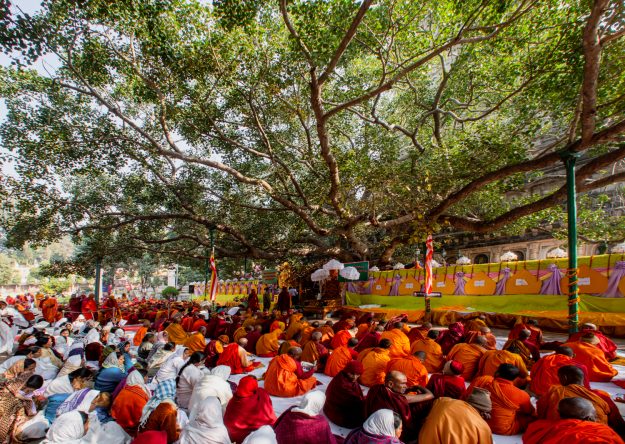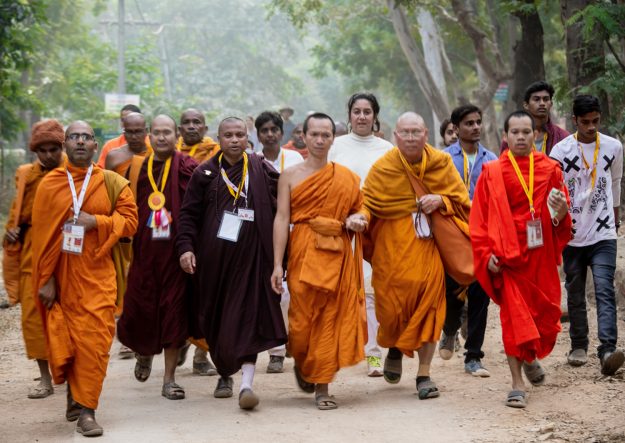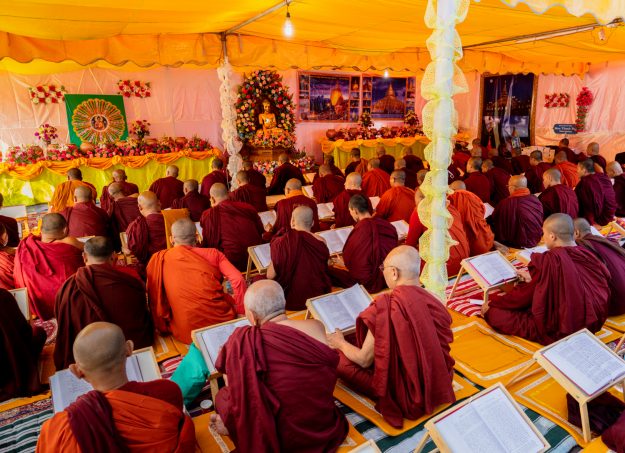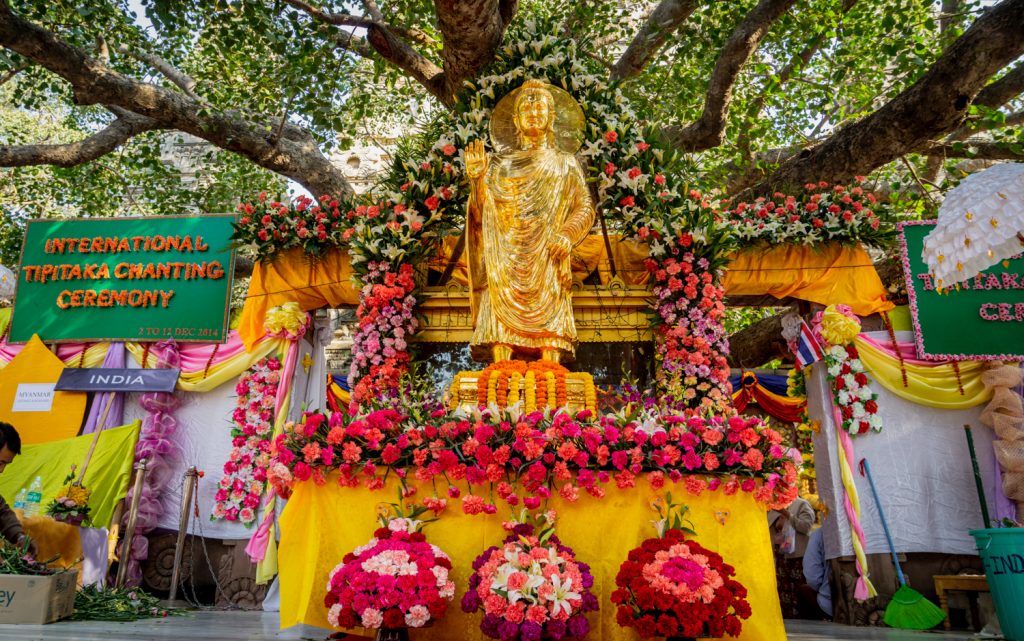After a two-year hiatus brought on by the pandemic, the International Tipitaka Chanting Program will return to India this year. When Wangmo Dixey, executive director of The Light of the Buddhadharma Foundation International (LBDFI), started the program 16 years ago, 250 local monks gathered to chant the Tipitaka, or the Pali canon, in Bodhgaya. The ceremony has since become one of the largest international gatherings in the Buddhist world, and, as Dixey explains, its impact extends far beyond the merit-making of reciting the sacred texts.
In the summer of 2005, Dixey’s father, Venerable Tarthang Tulku, asked his daughter to find ways to connect with the eleven countries of the South East Asian Theravada community, and encourage them to return to India, particularly to Bodhgaya. Tarthang Tulku, who brought the Nyingma tradition of Tibetan Buddhism to the United States, wanted to preserve and protect the roots of Buddhism in India. “Think of a pillar,” Dixey says. “If you don’t have a foundation, how can you have the top?”
Dixey grew up visiting Bodhgaya and was well versed in the power of gathering at the pilgrimage site thanks to her experience at the Nyingma Monlam Chenmo World Peace Ceremony, located there, which her father founded in 1989. She established the first Tipitaka Chanting Ceremony in February 2006, bringing together monks and Buddhist leaders, including the Dalai Lama and the Karmapa. In 2012, what had become an annual ceremony expanded outside of Bodhgaya to include chanting events at sacred sites like Vaisali, Shravasti, and Kushinagar. At the various pilgrimage sites, monks and local laypeople now recite the suttas that the Buddha taught there. “By bringing an auspicious event to a site, we support the local Indian people in reviving their sacred sites so they’re no longer seen as ancient monuments. They become alive through the sangha and the activity,” Dixey explains.
Every year concludes with a multi-day ceremony under the Bodhi tree, where monks from eleven countries gather to hear dharma talks and chant 1,000 pages of the Tipitaka. To date, the ceremony has brought together almost 50,000 participants, with around 5,000 participants gathering each year. This year’s program starts in New Delhi on March 22 and culminates in a 10-day ceremony in Bodhgaya starting on April 6, where the international sangha will finish chanting the Sutta Pitaka. The Light of the Buddhadharma Foundation International will also live stream certain events

Another significant development since the ceremony’s founding is the “one voice, one sound” initiative, which LBDFI introduced six years ago. At first, different sanghas would recite text simultaneously, which resulted in a cacophony of sound coming from all the different countries represented in Bodhgaya. Now, different countries’ sanghas take turns reciting parts of the Tipitaka. Every two days, a different country leads the chanting, which covers about 100 pages per day.
For the last two years, the pandemic made it unsafe for the ceremony to take place, but Dixey was determined to revive the tradition this year. “After a gap of two years, the local economy in Bodhgaya has really suffered, all the way from hoteliers, to shopkeepers, to rickshaw drivers,” Dixey says, referring to the major decrease in tourism spurred by COVID-19. “I hear in their voices a sense of sadness. The world should see the importance of making these places come alive.”

Though fewer monks will attend this year, the domain of the ceremony continues to grow with the addition of a new site: Lucknow, chosen to deepen the connection with the Ambedkar community.
The inclusion gets to the spirit of the Tipitaka Chanting Ceremony, which Dixey recalls by the generosity she observes each year. “The offerings are all so heartfelt. One year, we were in a big tent of 7,000 people, all being offered food by the lay people, when an older lady from Vietnam arrived. She came with a jar of honey that she had collected from her mountain village, and wanted to make it an offering,” Dixey says. “Coming from the West, where we have so much, to see this authentic giving is a teaching in itself.”
This year will also see the offering of a Maitreya statue—more than seven feet tall—to the main Bodhgaya temple. “For the first time, at the seat of enlightenment, we’re seeing the image of Maitreya,” Dixey says.
In addition to bringing together the communities and generating merit, the Tipitaka Chanting Program is also an important way for LBDFI to achieve its mission of revitalizing the roots of Buddhism in India. The Foundation doesn’t just support ceremonies and activate pilgrimage sites. It also impresses upon government officials the importance of these sites and works to support the local communities by encouraging economic development. Together with the Khyentse Foundation, The Corporate Body of the Buddha Educational Foundation, and the International Buddhist Confederation, LBDFI also prints and distributes dharma texts, and finally, perhaps most important to Dixey, the organization trains Indian monks.

“We aim to train 108 monks within all the Indian states to be the holders of the Buddhist Pali canon. In the 16 years of being on the ground, we’ve seen the need to offer encouragement to Indian Buddhist groups, and assist them in their role of representing the heartland of Buddhist culture.” Both through and outside of the Tipitaka Chanting Program, Dixey works to connect Theravada masters from Southeast Asia with monks in India to help strengthen Buddhist sanghas and practice on the subcontinent.
“I’ve learned so much from them and feel so blessed to be able to partake,” Dixey says of the masters and monks who come together for the chanting ceremony. “It shows us the true meaning of sangha and that it is possible to move from “I” to “we.”
♦
See here for more information and to join the Tipitaka Chanting Ceremony livestream.
Thank you for subscribing to Tricycle! As a nonprofit, we depend on readers like you to keep Buddhist teachings and practices widely available.
